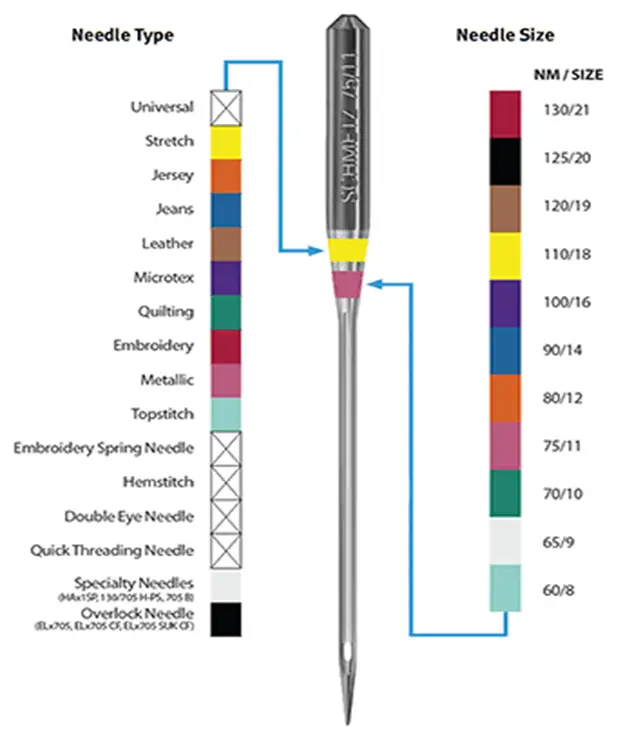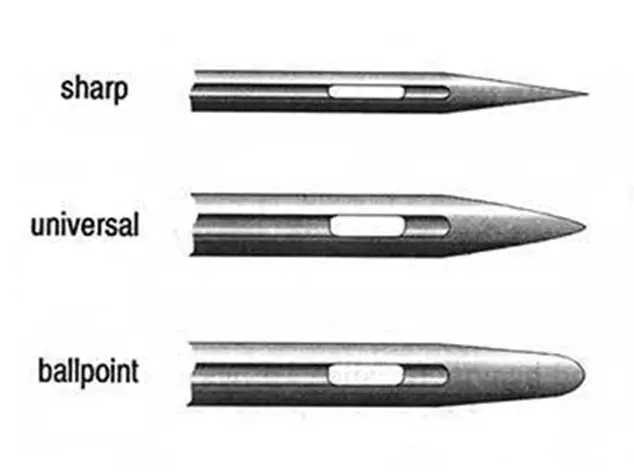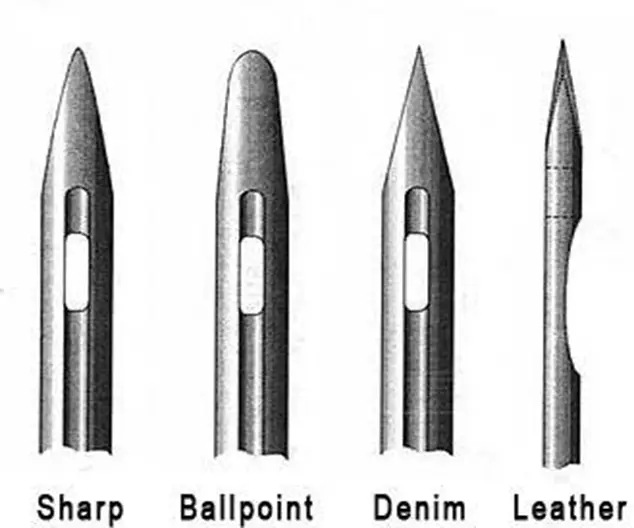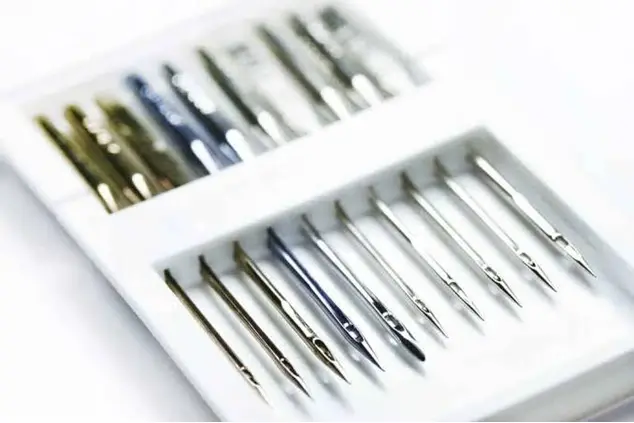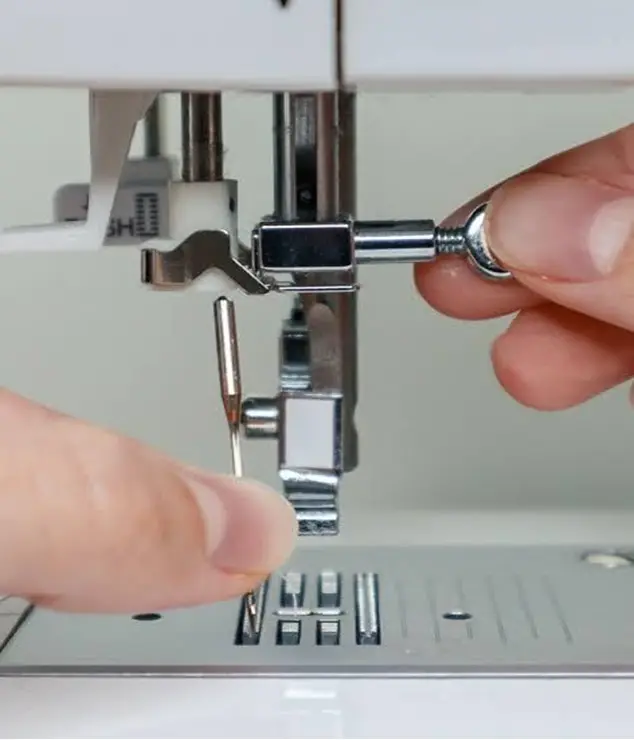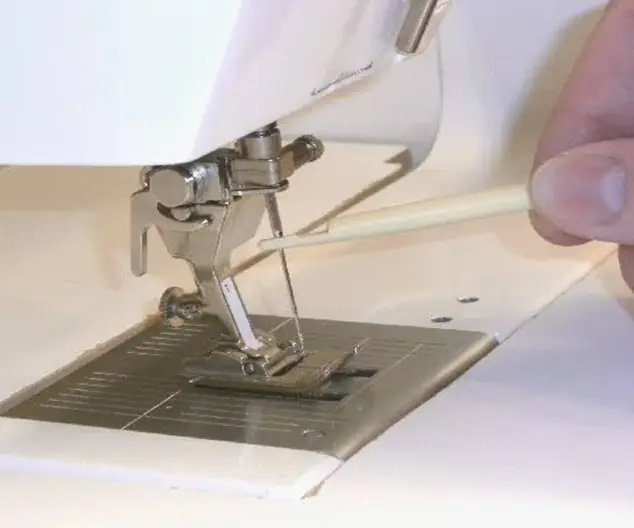Choose the best machine embroidery needle
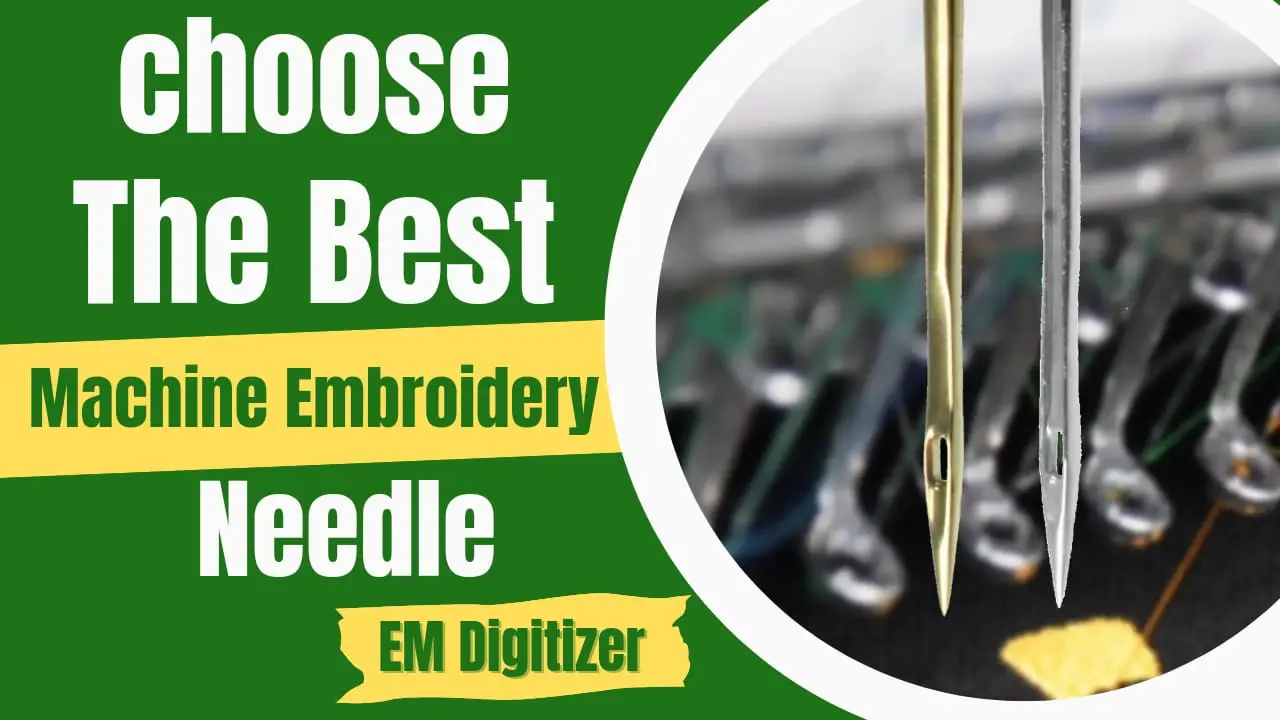
Choosing the right needle is overwhelming when there are thousands of options. So, there is a possibility of buying the wrong needle. But if you know the difference between numbers and needle sizes, it will be easy to get the right one. In this blog, we’ll talk about embroidery needles, their several types, their coating, and how to choose the proper size. Join us as we discuss selecting the best embroidery needle for your projects.
Table of Contents
Understand the anatomy of embroidery needles.
Here’s a picture showing the anatomy of a needle.
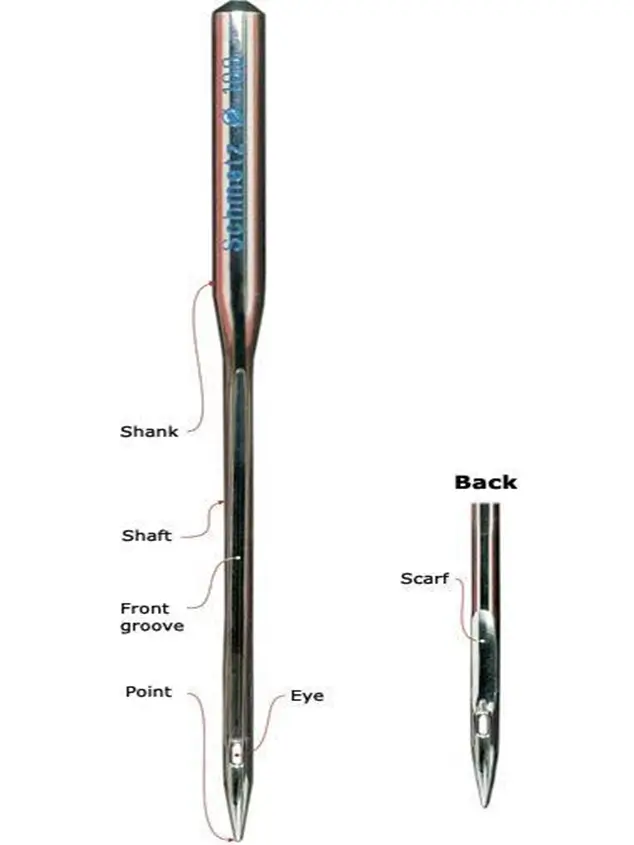
Eye- The smallest opening allows the thread to pass
Point– Tip of the needle for piercing fabric to make a stitch
Grove– The hollow area between the tip and needle eye that makes a loop of thread.
Shank- The upper needle area that fits into the needle bar of the embroidery machine.
Shaft– Body of needle starting from point to shank.
Scarf- A little groove on the needle’s back side that allows the hook to loop the thread around the bobbin case.
Difference between regular vs embroidery needles:
The embroidery needle has wide eyes and grooves that help prevent friction allowing trouble-free stitching.
Standard Needle size for embroidery
Needles come in a variety of sizes, but most embroidery designs require needles ranging from 65 to 90. You may use any of the mentioned needles that suit the machine, and the length is quite typical. It will be the same for home sewing, embroidery, or commercial machines. Here we have explained top needle options that all are interchangeable. For example, you don’t have to buy a singer needle to use with a singer machine, you can use anyone that works with your project. To check the number, if you have a micro camera in your phone, you will see a little stamp on the shank of the needle with the mentioned number. For more about commercial: you can visit:5 best commercial machine
1- 65/9
It is the smallest size needle. When digitizing minor details with the smallest satin stitch size, use a 65/9 needle size. This is to ensure that you do not have large fabric holes.
2- 70/10
We prefer this needle size for embroidered polo shirts. This size is not too big or too small.
3- 75/11
It is the thinnest needle and is considered a standard size. It can be used with many embroidery projects. It is suited best for lightweight fabrics such as silk. In addition, if you can’t decide which needle size you should choose, go with 75/11. For more about fabrics. you can visit: Best Types Of Embroidery Fabrics
4- 80/12
Another common needle size that embroiders use for tough materials such as caps or anything harder than normal stuff. If you have a very dense embroidery design, it is a great pick. Because it has a large eye that allows thread to pass through easily.
If you want to learn embroidery designs. you can visit: How To Organize Embroidery Designs
5- 90/14
It is a large-size needle that is also used with tougher fabrics. For example, if you are working with a heavy-weight thread such as metallic, go with a 90/14 needle. If you are looking for best brands of thread> you can visit: 5 Best Embroidery Thread Brands
6- Higher than 90
A needle size higher than 90 is a specialty needle. For example, 110/ 18 or 116 works best for very thick garments and threads.
Types of embroidery needles according to structure
We’re going to focus on the tip and the eye. Three common types of needlepoint are explained below:
Sharp point needle
We mostly use sharp point needles for embroidery projects. This sharp point penetrates and pierces through the fabric and creates little punchers in the fabric.
Ballpoint needle
This needle easily slips in through the thread so it won’t create a hole. If you are working on any fabric that has some stretch, use a ballpoint needle.
Universal
As the name suggests, you can use this universal needle for multiple embroidery projects. It sits somewhere in between a sharp and a ballpoint needle.
Note: We don’t recommend using this needle for projects like free-standing lace that use water soluble stabilizer.
A complete guid on stabilizer
When to choose a ballpoint and a sharp point needle?
When purchasing a needle for embroidery, consider the material with which it is used, such as fabric, thread, and stabilizer. To help you understand why you choose an embroidery needle over another needle, look at the example.
Choice of the needle according to fabric
1- If you’re sewing on something non-stretchy, such as towels or denim, use a sharp needle. It will poke through the material, cutting the fibers along the way. Because the material is not elastic, you won’t have to worry about premature fraying.
2– If you’re using knit fabric, such as 100% polyester material used in sports apparel, use a ballpoint needle. The ballpoint needle’s tip is somewhat rounded. It pushes the knitted fibers to the side rather than piercing them. Its unique design prevents skipped stitches. For more about skipped solution. you can visit: Top 5 causes and solutions of skipping stitches
3– If you are embroidering leather or anything involving leather like shoes or bags, make sure to use a tri-tip needle. It cuts through the leather without stretching it and gives a neat finished product.
Choice of the needle according to the thread
If you are going to change the size of the needle, also consider the size of the thread. It is to make sure that the thread is passing through the needle’s eye smoothly without friction. And it too involves a little bit of tension adjustment.
The best needle according to stabilizer
When embroidering, a good time to use a sharp needle is when you are using a water-soluble stabilizer. This needle helps to pierce through easily without ripping it.
Types of embroidery needles according to plating
Have a look at the different kinds of needles for their coating material.
1- Metallic needle
Although an embroidery needle can accommodate specialty thread like metallic thread. When using metallic thread, I specifically like to use a metallic needle. The reason is that it has an elongated and wider eye. With that needle type, the thread goes through more easily and avoids thread breakage. Also, I like to bump up the size from an 11 to a 14. That, too, helps avoid thread breakage. You can also look at getting something like these Schmetz embroidery gold needles.
2- Gold needle
The gold needle option has a similar description to the embroidery needle; however, the gold needles have a ceramic coating on them. The coating prevents sticking and friction. This is beneficial because we often use an adhesive spray with embroidery. Do you know how it can clog up on your needle? These needles specifically help with that problem.
3- Titanium needle
Titanium is extra strong and durable. If you’re dealing with things that are thicker or harder to pierce through or don’t want to add thickness go ahead and go with the titanium needle. It will increase the strength of your needle and let it last somewhat longer. Best to use for embroidering unstructured caps, bags, or 3d puff embroidery.
4- Chrome needle
Another great option is the chrome embroidery needles. For the bulk of needlework projects, remember that chromium is fine. They resist heat. They, too, resist wear so your needle lasts longer. The chrome also stays cooler, and longer to help reduce friction and stitch distortion.
5- Teflon-coated needle (specialty needle)
If you’re using peel-and-stick backing, the Teflon prevents your needle from gumming up causing premature thread breaks.
How often should you change the needle?
It’s usually recommended to either change it at the beginning of every project, or about every 8 hours of embroidering. Unless you’re using a metallic thread; then it is recommended to change it about every 4 hours of embroidering time. That’s because metallic thread is pretty hard on the needle so they wear quickly.
When should you change the needle?
If you want to know when should you change your needles, look at the following points:
- If you are having trouble with your stitches, they do not look nice or some other issues like skipped stitches, you need to change the needle.
- If your machine starts sounding different and a needle has to work harder to get through the fabric, change it.
- Different textiles demand different needles. So, when you change fabrics for the next project, you must use a new needle appropriate for the new cloth. Knitted cloth, for example, requires a different needle than denim does.
- If you only have a 75/11 needle and it doesn’t work with standard thread, try to loosen the top tension knob of the needle.
Maintenance of embroidery needle
Several oils on the market might impact both the needle and your skin. Some of these cause the needle to turn brown or black in some situations. It is a good idea to replace the needle regularly. You will also find a powder specially made for cleaning needles. Push the needle in and out and clean it off to make it run longer.
Best needle brands
Experts suggest Schmetz needles as their best brand but many different brands are also available. Some common ones are:
- Organ ballpoint needle ($7.25)
- Brother universal needle($3.99)
- Klasse ($7.84)
- Janome blue tip ($7.45)
- Groz- Beckert ($8.50)
- Singer ($7.63)
Conclusion
Selecting needles can be overwhelming at first. But we hope this blog helps you select the appropriate embroidery needle. We recommend having many of these different needle alternatives on hand. That way, you have options in case one doesn’t work out. Also, always test on fabric pieces similar to the project you will be working on.
FAQs
If you’re using a water-soluble stabilizer, embroider with a fine needle. It allows you to pierce through garments with ease without ripping.
Embroidery needles have wide eyes and grooves. The wide eye and groove will help prevent friction allowing trouble-free stitching.
If you’re using knit fabric, use a ballpoint needle. The ballpoint needle has a tip that is slightly rounded. It pushes the knitted fibers to the side, versus piercing them. This needle design helps eliminate skipped stitches.
80/12 is a typical needle size used on tough materials like caps and other hard-to-work items. If you have a very dense embroidery pattern, it is a good option. Because of its big eye, thread can easily slide through.
